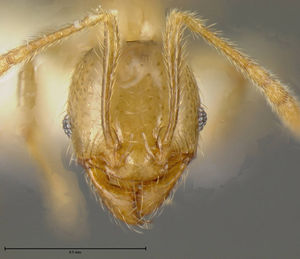Pheidole hasticeps
| Pheidole hasticeps | |
|---|---|

| |
| Scientific classification | |
| Kingdom: | Animalia |
| Phylum: | Arthropoda |
| Class: | Insecta |
| Order: | Hymenoptera |
| Family: | Formicidae |
| Subfamily: | Myrmicinae |
| Tribe: | Attini |
| Genus: | Pheidole |
| Species: | P. hasticeps |
| Binomial name | |
| Pheidole hasticeps Wilson, 2003 | |
Nothing is known about the biology of hasticeps.
Identification
See the description in the nomenclature section.
Keys including this Species
Distribution
Known from Costa Rica.
Latitudinal Distribution Pattern
Latitudinal Range: 17.509° to 9.7509026°.
| North Temperate |
North Subtropical |
Tropical | South Subtropical |
South Temperate |
- Source: AntMaps
Distribution based on Regional Taxon Lists
Neotropical Region: Colombia, Costa Rica (type locality), Mexico, Panama.
Distribution based on AntMaps
Distribution based on AntWeb specimens
Check data from AntWeb
Countries Occupied
| Number of countries occupied by this species based on AntWiki Regional Taxon Lists. In general, fewer countries occupied indicates a narrower range, while more countries indicates a more widespread species. |

|
Estimated Abundance
| Relative abundance based on number of AntMaps records per species (this species within the purple bar). Fewer records (to the left) indicates a less abundant/encountered species while more records (to the right) indicates more abundant/encountered species. |

|
Biology
Castes
Worker
Minor
Images from AntWeb
  
| |
| Worker. Specimen code casent0635471. Photographer J. Longino, uploaded by University of Utah. | Owned by JTLC. |
Nomenclature
The following information is derived from Barry Bolton's Online Catalogue of the Ants of the World.
- hasticeps. Pheidole hasticeps Wilson, 2003: 704, figs. (s.w.) COSTA RICA.
Unless otherwise noted the text for the remainder of this section is reported from the publication that includes the original description.
Description
DIAGNOSIS Closely similar to Pheidole subarmata, but differing by the following traits.
Major: larger and more darkly colored; pronotum bilobous; propodeal spines longer and thinner, postpetiolar nodal margins more sharply angulate; carinulae mesad to the eyes extend halfway to the occipital border.
Minor: larger and darker, otherwise nearly identical to Pheidole subarmata. See also the less similar Pheidole allarmata, Pheidole cramptoni, Pheidole synarmata and Pheidole triplex.
MEASUREMENTS (mm) Holotype major: HW 1.20, HL 1.40, SL 0.60, EL 0.16, PW 0.64. Paratype minor: HW 0.52, HL 0.54, SL 0.54, EL 0.10, PW 0.34.
COLOR Major: head and body dark brown, appendages light to medium brown.
Minor: head and body medium brown, appendages light brown.
Figure. Upper: holotype, major. Lower: paratype, minor. Scale bars = 1 mm.
Type Material
COSTA RICA: San José de la Montaña, 10 km north of Heredia, col. Yvette Perfecto. Museum of Comparative Zoology
Etymology
L hasticeps, spear-headed, referring to the major.
References
- Guerrero, R.J., Fernandez, F., Escarraga, M.E., Perez-Pedraza, L.F., Serna, F., Mackay, M.P., Sandoval, V., Vergara, V., Suarez, D., Garcia, E.I., Sanchez, A., Meneses, A.D., Tocora, M.C., Sosa-Calvo, J. 2018. New records of myrmicine ants (Hymenoptera: Formicidae) for Colombia. Revista Colombiana de Entomología 44: 238-259 (DOI 10.25100/socolen.v44i2.7115).
- Wilson, E. O. 2003. Pheidole in the New World: A dominant, hyperdiverse ant genus. Harvard University Press, Cambridge, MA. (page 704, fig. major, minor described)
References based on Global Ant Biodiversity Informatics
- Dattilo W. et al. 2019. MEXICO ANTS: incidence and abundance along the Nearctic-Neotropical interface. Ecology https://doi.org/10.1002/ecy.2944
- Fernández, F. and S. Sendoya. 2004. Lista de las hormigas neotropicales. Biota Colombiana Volume 5, Number 1.
- Longino J. T. L., and M. G. Branstetter. 2018. The truncated bell: an enigmatic but pervasive elevational diversity pattern in Middle American ants. Ecography 41: 1-12.
- Longino J. et al. ADMAC project. Accessed on March 24th 2017 at https://sites.google.com/site/admacsite/

